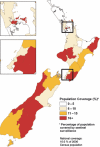Influenza surveillance and immunisation in New Zealand, 1997-2006
- PMID: 19453466
- PMCID: PMC4634224
- DOI: 10.1111/j.1750-2659.2008.00050.x
Influenza surveillance and immunisation in New Zealand, 1997-2006
Abstract
Background: The national influenza surveillance in New Zealand is an essential public health component for assessing and implementing strategies to control influenza.
Objective: The aim of this study is to report the national influenza surveillance data collected during 1997-2006 in terms of the community disease burden, circulating viral strains, hospitalisations, mortality, and immunisation coverage.
Methods: The national influenza surveillance system includes sentinel general practice surveillance, laboratory-based surveillance, and hospital admission and mortality surveillance and immunisation coverage. The results obtained during 1997-2006 were analysed.
Results: When the last 10 years were compared to the previous years, sentinel general practice surveillance recorded a decreasing trend of influenza-like illness rates in the community. Sentinel surveillance also showed that children aged 0-4 years were the most affected. Influenza-related hospitalisation surveillance reported an increasing trend of hospital admissions particularly in children aged 0-19 years. Introduction of routine influenza vaccination among the New Zealand elderly was associated with a significant decrease of influenza-related mortality.
Conclusions: This report demonstrates that an integrated virological and epidemiological surveillance system for influenza is essential for monitoring the disease burden, identifying circulating strains, guiding effective vaccination and planning for a potential pandemic.
Figures
References
-
- Ministry of Health NZ . Immunisation Handbook 2002. Wellington: Ministry of Health, New Zealand, 2002.
-
- Jennings L, Huang QS, Baker M et al. Influenza surveillance and immunisation in New Zealand 1990–1999. N Z Public Health Rep 2001;8:9–16.
-
- Huang QS, Lopez L, Adlam B. Influenza surveillance in New Zealand in 2005. N Z Med J 2007;120:U2581. - PubMed
-
- Bohmer PD, Jennings LC, Smith LB et al. The national influenza immunisation strategy group: a New Zealand model for influenza vaccination promotion. Int Congr Ser 2004;1263:799–804.
-
- Elliot AJ, Fleming DM. Surveillance of influenza‐like illness in England and Wales during 1966–2006. Euro Surveill 2006;11:249–250. - PubMed
Publication types
MeSH terms
Substances
LinkOut - more resources
Full Text Sources
Medical





